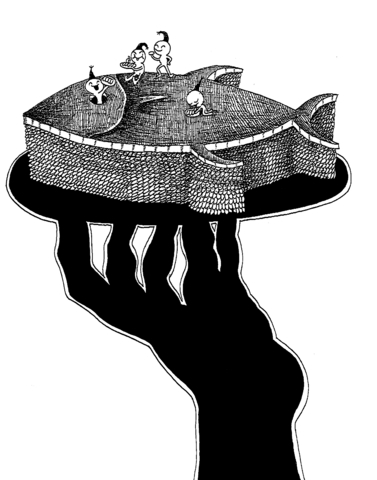In the dark green waters off the coast of western Japan, scores of 68kg bluefin tuna glided counterclockwise inside a pen 46m in diameter, the telltale blue streaks on their bodies shimmering just below the surface.
The fish, though, were not just any kind of bluefin tuna, whose fatty flesh is the most prized delicacy at exclusive sushi restaurants in Japan and has set off fishing wars in the world's oceans. They represented the holy grail of fish breeding: bluefin tuna born and raised in captivity.
They were also the lifework of the man shoveling mackerel into the pen from the edge of a boat one recent afternoon, Hidemi Kumai, 71, the head of Kinki University's Fisheries Laboratory. Kumai had spent more than three decades trying to farm the bluefin tuna -- an unusually delicate fish, both physically and psychologically, prone to everything from restlessness to cannibalism -- before succeeding in 2002. Two years later, he began sending it off to sushi counters in Osaka and Tokyo.

"I felt as if I were giving away my daughters in marriage," Kumai said.
When he undertook his quest in 1970, tuna were plentiful in Japanese waters and the Japanese were really the only people interested in eating slices of raw fish. Today, even as the popularity of sushi keeps increasing worldwide, overfishing and pollution have pushed down edible fish stocks.
The competition has become fiercest over the bluefin tuna, which fetches about US$110 a pound at the Tsukiji fish market in Tokyo, the world's biggest. Of the five kinds of tuna eaten in Japan, bluefin accounts for less than 2 percent. But fishermen from New Zealand to Libya comb seas for it; in Croatia, Spain and elsewhere, young bluefin tuna are caught and fattened inside giant underwater cages before being shipped to Japan.
Despite international quotas, the appetite for bluefin tuna is so insatiable that in the Mediterranean it is on the verge of extinction, according to the World Wildlife Fund. To curb quota violations and what the industry calls tuna laundering, Japanese officials have started carrying out DNA tests on imported bluefin tuna.
The Japanese, who eat about 80 percent of the world's bluefin tuna, are now contending with competition from, predictably, the Chinese. As Chinese in Beijing and Shanghai become sushi devotees, they are paying top dollar for bluefin. Some of the best sushi restaurants in Japan are grumbling that bluefin has become too expensive and hard to buy -- and that they might scratch tuna from their menus instead of suffering the indignity of serving the cheap stuff.
There is a "high possibility," Kumai said, that in a decade or two, as China keeps getting richer, Japan may simply be priced out of a shrinking bluefin market.
"Now only Chinese in the coastal areas are eating sushi or can afford to," Kumai said. "What happens when the Chinese in the vast hinterland start eating sushi?"
As part of Japan's national interest, and also because the Japanese have been exhausting the world's tuna stocks, Kumai advocated the large-scale farming of bluefin tuna, led by the government.
"This has to be a national project," he said. "Now Americans and Chinese are eating sushi, so we can't just sit back."
The outside threat has added urgency to Kumai's work, one that he had never imagined when he began fish farming in the late 1950s. As a boy growing up in the landlocked prefecture of Nagano, he had longed to see the ocean, but World War II restricted travel. When he finally caught a glimpse of the sea during a junior high school trip, he was hooked.
Over the years, the university's Fisheries Laboratory was first in the captive breeding of about 20 fish species, including halibut, flat bream and Japanese amberjack. Much of the work went on in the placid Pacific waters between the town of Kushimoto and the small island of Oshima, where various fish are farmed inside pens.
But bluefin are the main attraction. At first, capturing young bluefin in the wild and transporting them into pens proved difficult, with most of them dying in fishermen's nets. Bluefin bruise easily because of their delicate scales, and their gills take in little oxygen compared to other fish, so they have to swim continuously to breathe -- even while asleep.
Cooped up, many died quickly. Eventually, Kumai learned how to keep them alive and scored a first in 1979 when the fish spawned inside a pen. Still, after hatching, the fry died after a few weeks -- a cycle that went on until 1982, when the fish inexplicably stopped spawning.
They resumed in 1994, but new problems arose. The fry survived, but the bigger ones kept gobbling up their little brethren.
"Other fish, the sea bream or flatfish, do that, too," Kumai said. "But tuna are very aggressive. The population could shrink to a third overnight."
Kumai scooped the fry into bowls -- their delicate bodies would chafe at nets -- and segregated them by size. Unlike other species, they quickly grew tails but lagged behind in developing other fins -- so that they could advance but not turn.
"They kept crashing into nets and dying," Kumai said with a grave face. "We took X-rays and found their necks were broken."
For fish that can grow to be as large as 800kg, they are also unusually sensitive. Fireworks, even the headlight of a car, can cause them to panic, crash into nets and break their necks.
Nevertheless, many survived and spawned eggs. In 2002, these eggs hatched and the fry survived. By segregating the fry from the larger fish, raising them in bigger pens and adjusting the water temperature and their diet through trial-and-error experiments over the years, he was able to raise them to adulthood. In 2004, these fully farmed bluefin tuna were sold to an expectant nation.
"I've never met anyone who told me it tastes bad, though I know it's hard to say that to my face," said Kumai, who said he had never eaten wild bluefin.
Some sushi chefs in Kushimoto sniff at the ranched bluefin, saying it yields a fatty meat that does not taste as good as the wild variety. Wild bluefin, migrating across oceans, tend to be lean. But Kumai's couch potatoes are 10 percent lean and 90 percent fatty.
Because of decreasing stocks, Kumai's bluefin is now sold only once a month at a Mitsukoshi department store in Tokyo -- for a third less than the wild kind. That fact annoyed Kumai.
"Just because it's farmed, the prices are automatically lower," he said. "If it's good, it's good. There shouldn't be a difference."

There is much evidence that the Chinese Communist Party (CCP) is sending soldiers from the People’s Liberation Army (PLA) to support Russia’s invasion of Ukraine — and is learning lessons for a future war against Taiwan. Until now, the CCP has claimed that they have not sent PLA personnel to support Russian aggression. On 18 April, Ukrainian President Volodymyr Zelinskiy announced that the CCP is supplying war supplies such as gunpowder, artillery, and weapons subcomponents to Russia. When Zelinskiy announced on 9 April that the Ukrainian Army had captured two Chinese nationals fighting with Russians on the front line with details
On a quiet lane in Taipei’s central Daan District (大安), an otherwise unremarkable high-rise is marked by a police guard and a tawdry A4 printout from the Ministry of Foreign Affairs indicating an “embassy area.” Keen observers would see the emblem of the Holy See, one of Taiwan’s 12 so-called “diplomatic allies.” Unlike Taipei’s other embassies and quasi-consulates, no national flag flies there, nor is there a plaque indicating what country’s embassy this is. Visitors hoping to sign a condolence book for the late Pope Francis would instead have to visit the Italian Trade Office, adjacent to Taipei 101. The death of
By now, most of Taiwan has heard Taipei Mayor Chiang Wan-an’s (蔣萬安) threats to initiate a vote of no confidence against the Cabinet. His rationale is that the Democratic Progressive Party (DPP)-led government’s investigation into alleged signature forgery in the Chinese Nationalist Party’s (KMT) recall campaign constitutes “political persecution.” I sincerely hope he goes through with it. The opposition currently holds a majority in the Legislative Yuan, so the initiation of a no-confidence motion and its passage should be entirely within reach. If Chiang truly believes that the government is overreaching, abusing its power and targeting political opponents — then
The Chinese Nationalist Party (KMT), joined by the Taiwan People’s Party (TPP), held a protest on Saturday on Ketagalan Boulevard in Taipei. They were essentially standing for the Chinese Communist Party (CCP), which is anxious about the mass recall campaign against KMT legislators. President William Lai (賴清德) said that if the opposition parties truly wanted to fight dictatorship, they should do so in Tiananmen Square — and at the very least, refrain from groveling to Chinese officials during their visits to China, alluding to meetings between KMT members and Chinese authorities. Now that China has been defined as a foreign hostile force,